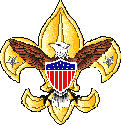| MERIT BADGES |
|
|
|
|
| Note: Eagle Required are in Italics |
"A"
American
Business
American Culture
American Heritage
American Labor
Animal Science
Archaeology
Archery
Architecture
Art
Astronomy
Athletics
Atomic Energy
Auto Mechanics
Aviation
"B"
Backpacking
Basketry
Bird Study
Bugling
"C"
Camping
Canoeing
Chemistry
Cinematography
Citizenship
Community*
Citizenship Nation*
Citizenship World*
Climbing
Coin Collecting
Collections
Communications*
Computers
Cooking
Crime Prevention
Cycling*
"D"
Dentistry
Disability Awareness
Dog Care
Drafting
"E"
Electricity
Electronics
Emergency
Preparedness**
Energy
Engineering
Entrepreneurship
Environmental
Science*
"F"
Family Life*
Farm Mechanics
Fingerprinting
Fire Safety
First Aid*
Fish & Wildlife Mgmt.
Fishing
Fly Fishing
Forestry
"G"
Gardening
Genealogy
Geology
Golf
Graphic Arts
"H"
Hiking
Home Repairs
Horsemanship
"I"
Indian Lore
Insect Studies
"J"
Journalism
"K"
"L"
Landscape Architecture
Law
Leatherwork
Lifesaving**
"M"
Mammal Study
Medicine
Metalwork
Model Design & Building
Motorboating
Music
"N"
Nature
"O"
Oceanography
Orienteering
"P"
Painting
Personal Fitness**
Personal Management*
Pets
Photography
Pioneering
Plant Science
Plumbing
Pottery
Public Health
Public Speaking
Pulp and Paper
"Q"
"R"
Radio
Railroading
Reading
Reptile & Amphibian Study
Rifle Shooting
Rowing
"S"
Safety
Salesmanship
Scholarship
Sculpture
Shotgun Shooting
Skating
Skiing
Small Boat Sailing
Soil & Water
Conservation
Space Exploration
Sports**
Stamp Collecting
Surveying
Swimming**
"T"
Textile
Theatre
Traffic Safety
Truck Transportation
"U"
"V"
Veterinary Medicine
"W"
Water Skiing
Weather
Whitewater
Wilderness Survival
Wood Carving
Woodwork
"X"
"Y"
"Z"
 Electricity ElectricityRequirements 1996 |
- Show magnetic attraction and repulsion. Make and use a simple electromagnet.
- Explain the difference between a direct current and an alternating current.
- Make a simple drawing to show how a chemical cell and an electric bell work.
- Explain why a fuse blows or a circuit breaker trips. Tell how to find a blown fuse or tripped circuit breaker in your home. Show how to change the fuse or reset the circuit breaker safely.
- Explain what overloading an electric circuit means. Tell what you have done to make sure your home circuits aren't overloaded.
- Demonstrate how to repair a plug on an appliance cord.
- Show how to rescue a person touching a live wire in the home. Show first aid if the person is unconscious from electrical shock.
- Show on a floor plan of a room in your home the lights, switches, and outlets. Show which fuse or circuit breaker protects each.
- Read an electric meter. Figure an electric bill from meter readings.
- Explain 10 electrical terms such as volt, ampere, watt, ohm, resistance, potential difference, rectifier, rheostat, conductor, ground, circuit, or short circuit.
- Do any TWO of the following:
- Connect a buzzer, bell or light with a battery. Have a key or switch in the line.
- Make and run a simple electric motor (not from a kit).
- Build a simple rheostat. Show that it works.
- Build a single-pole double-throw switch. Show that it works.
- Hook a model electric train layout to a house circuit. Tell how it works.
|
||||||
Last Update May 15, 2023

.jpg)
